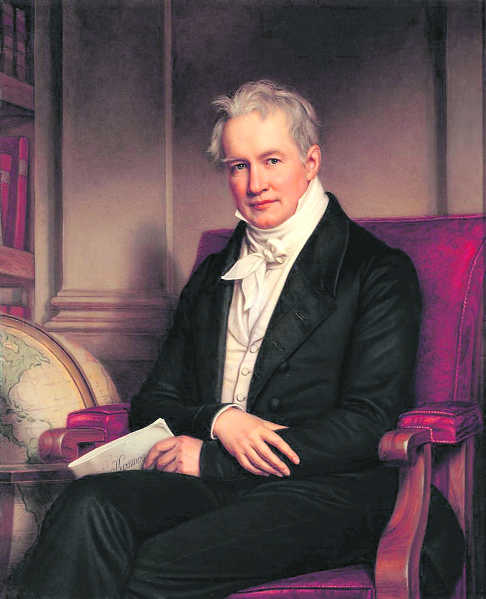
Alexander Von Humboldt was the first scientist to talk about human-induced climatic changes and our obligations to the environment
Kuldip Singh Dhir
The book is a gripping biography of Alexander Von Humboldt (1769-1859) which restores the scientific superstar to his rightful place in the pantheon of science. He was an explorer and a naturalist with contributions in geography, botany, climatology and geophysics. Taking us on a fantastic voyage in the footsteps of perhaps the greatest traveller-scientist, Wulf shows why his life and ideas are so important today.
During much of his lifetime Humboldt was the nexus of the scientific world. He wrote some 50,000 letters and received at least double the number. Knowledge, he believed had to be shared and exchanged. Wulf captures Humboldt as a man of contradictions. He is a fierce critic of colonialism and supporter of revolutions yet chamberlain to kings. We see him admire the US for its concepts of equality and liberty but bashing it for its failure to abolish slavery. He is confident yet yearns for approval. He is admired for his breadth of knowledge but feared for his sharp tongue. His books were published in a dozen of languages and were so popular that people bribed publishers to get them, yet he died a poor man. He could be vain but would give his last penny to a struggling scientist. He had an encyclopedic knowledge but was not a cerebral scholar. Observations, Instruments and measurements had a place in his scheme of things, but he believed that our response to the natural world should be based on senses and emotions. At a time when other scientists were searching for universal laws, he opted for experiencing nature through feelings.
Wulf gives a dramatic account of Humboldt remembering the smallest details for years, which enable him to compare observations made by him several decades or thousands of miles apart. A visionary, he invented isotherms and discovered magnetic equator. He revolutionalised the way we see the natural world. He was the first scientist to talk about human-induced climatic changes and our obligations to the environment.
He interacted with and influenced a host of great minds of his day, which include Goethe, Charles Darwin, Wordsworth, Coleridge, Thoreau, Thomas Jefferson and Simon Bolivar. Almost 300 plants and more than 100 animals are named after him. A town, a river, an ocean-current, a geyser, a bay and even an area on the Moon carry his name. Rachel Carson’s Silent Spring is based on his concept of inter-connectedness. James Lovelock’s Gaia Theory of Earth as a living organism has its roots in Humboldt.
To resurrect Humboldt, Wulf visited the archives at Cambridge, Berlin and California. She visited the ruins of an anatomy tower at Jena where Humboldt spent weeks dissecting animals. She pursued Darwin’s personal copies of Humboldt’s books with his pencil-marks, giving us a feel of eavesdropping on Darwin talking to Humboldt. She walked down Walden Pond and climbed Chimborazo volcano that was so elemental to the scientist’s vision.
Divided into five sections, the first section of the biography traces first 25 years of his life. The second begins with his voyage to Venezuela from Spain. We see him explore the coastal areas and travel into hazardous regions of America. He continues across the Andes and Chimborazo and settles for sometime in Washington to exchange his views with President Jefferson. The third part takes us around London, Berlin and Paris. Here we see among other things, two great minds Simon Bolivar and Humboldt discuss problems of revolutions. Penultimate section gives a vivid account of Humboldt’s relationship with Darwin and Thoreau. It also gives us a peep into his publications, which run into thousands of pages. The last section describes the evening of Humboldt’s life and his death in 1859. Wulf does not end her account abruptly. In the 50 pages that follow, she gives a glimpse of Humboldt’s influence on his contemporaries, connecting nature with man, ecology and preservation. GP March, Ernst Haeckel and John Muir are the central figures here.
Andrea Wulf has worked really hard to create this biography which is evident from some 150 pages of notes, bibliography and index of the book. One may wonder as to why Humboldt has been forgotten today in spite of all his achievements. There are possibly two reasons. Humboldt was one of the last polymaths who died at a time when scientific disciplines were hardening into tightly fenced specialised fields. His holistic approach has fallen out of favour now. Another reason is the anti-German sentiment all over the world consequent to the two World Wars in which Germany played the villain. Goethe compared Humboldt to a fountain with many spouts that will never run dry.



























